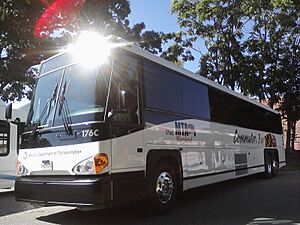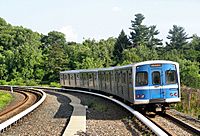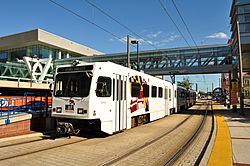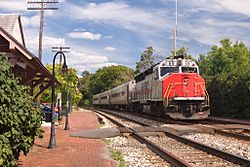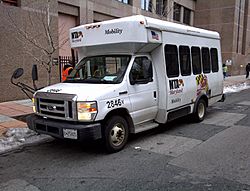Maryland Transit Administration facts for kids
Quick facts for kids Maryland Transit Administration |
|
|---|---|
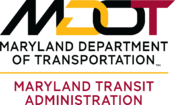 |
|
| Info | |
| Locale | Washington-Baltimore metropolitan area |
| Transit type | Bus, Light rail, Rapid transit, Commuter rail |
| Number of lines | Heavy rail: 1 Light rail: 3 Commuter rail: 3 Bus: 80 |
| Number of stations | Heavy rail: 14 Light rail: 33 Commuter rail: 43 |
| Daily ridership | 219,300 (weekdays, Q1 2023) |
| Chief executive | Holly Arnold |
| Operation | |
| Began operation | April 30, 1970 |
| Operator(s) | Maryland Department of Transportation |
| Number of vehicles | Heavy Rail: 100 Light Rail: 53 Commuter rail: 175 Bus: 842 Mobility vans: 303 Mobility sedans: 124 (2010) |
| Technical | |
| System length | Heavy rail: 15.2 miles (24.5 km) Light rail: 30 miles (48 km) Commuter rail: 187 miles (301 km) |
| Track gauge | 4 ft 8 1⁄2 in (1,435 mm) standard gauge |
The Maryland Transit Administration (MTA) is a public transportation system in Maryland. It is part of the Maryland Department of Transportation. The MTA helps people travel around the Washington-Baltimore area.
It has 80 bus lines in the Baltimore Metropolitan Area. It also offers train services like the Light Rail, Metro Subway, and MARC Train. In 2022, about 52,922,000 trips were made on the system. This means about 219,300 trips happened each weekday as of the first quarter of 2023.
Many people in Baltimore do not own a car. So, the MTA is a very important way for them to get around. The MTA connects with other transit systems in Maryland, Washington, D.C., Northern Virginia, and south-central Pennsylvania. These include WMATA, Charm City Circulator, and Rabbit Transit.
Contents
History of the MTA
The MTA started on April 30, 1970. It took over from the old Baltimore Transit Company. First, it was called the Baltimore Metropolitan Transit Authority. Then, it became the Mass Transit Administration. In October 2001, it got its current name.
Many of the bus routes today follow the paths of old streetcar lines. These streetcars ran from the 1890s to the 1960s. Over time, streetcar routes changed to bus routes. Some were combined or extended to serve new areas.
As more people bought cars, fewer rode streetcars and buses. Public transportation in Baltimore changed from private companies to state-run services. Many routes were cut back. Some areas once served by streetcars now have very little bus service.
Baltimore's streetcars stopped running between 1947 and 1963. Buses were cheaper and easier to maintain. But rail transit came back! The Metro Subway opened in 1983. The Light Rail started in 1992. The old streetcar tracks had a unique width of 5 ft 4 1⁄2 in (1,638 mm).
Bus Services
The MTA runs bus services mostly in the Baltimore metropolitan area. Some buses connect to the Washington, D.C., area, Kent Island, and western Maryland. Local buses serve Baltimore city and nearby areas like Baltimore County and Anne Arundel County. Some routes connect different suburban towns.
Local Bus Routes
Since 2017, local MTA bus routes have new names. They are either CityLink (with colors) or LocalLink (with numbers). CityLink buses run more often and for longer hours. But both types are part of the same network. Their schedules change based on the day and time. Many of these routes come from older streetcar lines.
CityLink routes have a color and a two-letter code. For example, CityLink Green (GR). Some colors are similar, like Green and Lime. Also, other bus services in Baltimore use similar color names.
LocalLink routes are numbered. Numbers 21–38 are often "crosstown" routes. Numbers 51–95 are usually "feeder" routes. But not every number is used. Some LocalLink lines also run very often or 24 hours a day.
In April 2022, the MTA suggested a new LocalLink 32 route. It would replace part of the CityLink Yellow route that goes to the University of Maryland, Baltimore County.
Quickbus and QuickLink
Before June 2017, the MTA had "Quickbus" routes. These buses made fewer stops to save time. In 2022, the MTA brought back the QuickLink 40 route. It is similar to the old Quickbus 40.
Neighborhood Shuttle Bug
Until June 2017, the MTA had two special shuttle routes. These were the Mondawmin Shuttle Bug (Route 97) and the Hampden Shuttle Bug (Route 98). They had their own unique colors and logos.
Express Bus Routes
The MTA runs 9 express bus lines in the Baltimore area. These are routes 103, 105, 115, 120, 150, 154, 160, and 163.
Commuter Bus Routes
Other bus companies run 26 commuter bus routes. These connect the Washington, D.C., and Baltimore areas. Five routes (300s and 400s) go to Baltimore. Sixteen routes (600s and 900s) go to Washington. Routes 201-205 travel on MD 200.
Rail Services
Metro Subway
The Metro Subway runs above and below ground. It goes from Owings Mills in Baltimore County to downtown Baltimore. It also reaches the Johns Hopkins Medical Center. This route is 15.5-mile (24.94 km) long and has 14 stations.
In the busiest parts of the city, the subway runs underground. Outside the city, it runs above ground. The Owings Mills station is part of a large development. It includes a public library and college classrooms. More homes and businesses are planned there.
There were plans to extend the subway northeast. If this happens, the line might be called the Green Line. Another line, the Red Line, was planned but cancelled in 2017.
Light Rail
The Light RailLink goes from Hunt Valley in Baltimore County. It travels through the suburbs and into downtown Baltimore. It passes the harbor and goes to BWI Marshall Airport and Cromwell Station. There is also a branch to Amtrak's Baltimore Penn Station.
The Light Rail mostly runs at ground level. It crosses some water on bridges. There are 33 stations on the 30.0-mile (48.28 km) system. Most of the line now has two tracks, making it more efficient.
Commuter Rail (MARC Train)
The MARC Train has three lines. It provides commuter rail service for people traveling to and from Baltimore, Washington, D.C., Frederick, Perryville, and Martinsburg, WV. It also stops at many places in between.
Mobility Services
Paratransit
The MTA started offering paratransit service in 1978. This service helps people with disabilities get around. It uses special vans and cars. These vehicles offer "non-fixed route" service, meaning they don't follow a set schedule or path.
Taxi Access Program
The Taxi Access program is part of Paratransit. It lets people who qualify for Paratransit use a taxi. The taxi takes them door-to-door within certain areas. The customer pays $3.00, and the MTA pays the rest of the fare.
Future and Proposed Services
The MTA is building the Purple Line. This is a light rail system between Bethesda and New Carrollton. It is expected to open for passengers in late 2027.
The MTA has also studied other proposed lines. These included the Red Line (an east-west light rail) and the Green Line (a north-south subway extension). Both of these projects were cancelled in 2015. The Corridor Cities Transitway is also being looked at for new bus or light rail service.
BaltimoreLink
BaltimoreLink is a big update to the MTA bus service in Baltimore. Governor Larry Hogan announced it in 2015. It was a $135 million plan to improve the transit system. This plan came after the Red Line and Green Line light-rail projects were cancelled.
Bus Service Types
BaltimoreLink has three types of bus service: CityLink, ExpressLink, and LocalLink. You can find maps of the system online.
CityLink Routes
CityLink routes are named after colors.
- CityLink Blue (BL): CMS / Westgate <-> Hopkins Bayview
- CityLink Brown (BR): Overlea <-> University Of Maryland Medical Center
- CityLink Gold (GD): Walbrook Junction <-> Berea / Canton Crossing
- CityLink Green (GR): Towson <-> Inner Harbor
- CityLink Lime (LM): Northwest Hospital <-> Druid Hill Park / Harbor East
- CityLink Navy (NV): Watersedge / Dundalk <-> Mondawmin Metro Station
- CityLink Orange (OR): Fox Ridge (Essex) <-> West Baltimore MARC Station
- CityLink Pink (PK): Cedonia <-> West Baltimore MARC Station
- CityLink Purple (PR): Rt. 40 & Rolling Road <-> City Hall
- CityLink Red (RD): Lutherville / Towson <-> University of Maryland Transit Center / Greenmount North
- CityLink Yellow (YW): Patapsco Light Rail Station / Beltway Bus. Park <-> Mondawmin Metro Station
- CityLink Silver (SV): Curtis Bay <-> Johns Hopkins University / Morgan State University
Quicklink Routes
- Quick Link 40: Essex <-> North Bend
Express BusLink Routes
- Express Bus Link 103: Cromwell <-> Inner Harbor
- Express Bus Link 105: Cedonia <-> Lexington Market Metro
- Express Bus Link 115: Perry Hall <-> Lexington Market Metro / North Ave
- Express Bus Link 120: White Marsh Park & Ride <-> Charles Ctr. and Johns Hopkins Hospital
- Express Bus Link 150: Columbia <-> Harbor East
- Express Bus Link 154: State Center Metro <-> Carney / Hillendale
- Express Bus Link 160: Charles Ctr. and Johns Hopkins Hospital <-> Essex / Whispering Woods
- Express Bus Link 163: West Baltimore Marc <-> Tradepoint Atlantic
LocalLink Routes
LocalLink routes are numbered.
- No. 21 Woodberry Light Rail Station <-> Canton Crossing
- No. 22 Bayview <-> Mondawmin Metro Station
- No. 26 Patapsco Light Rail Station <-> Mondawmin Metro Station
- No. 28 Moravia <-> Rogers Ave Metro Station
- No. 29 Mondawmin Metro Station <-> Brooklyn Homes
- No. 30 Rogers Ave Metro Station <-> Hollander Ridge
- No. 31 Sinai Hospital <-> Security Square Mall via Rogers Ave Metro
- No. 32 Patapsco Light Rail Station <-> Catonsville
- No. 33 White Marsh <-> Mt. Washington Light Rail Station
- No. 34 Falls Rd Light Rail Station/Greenspring Station <-> Westview Mall
- No. 36 Essex (Fox Ridge) <-> Towson
- No. 37 Old Court Metro <-> UMBC/Catonsville
- No. 51 Towson <-> Downtown
- No. 52 Stella Maris <-> Greenmount North
- No. 53 Sheppard Pratt / Cromwell Bridge <-> State Center Metro Station
- No. 54 Hillendale/ Carney Park & Ride <-> State Center Metro Station
- No. 56 White Marsh Park & Ride <-> Downtown (Fayette Plaza)
- No. 57 Belair-Edison Shuttle
- No. 59 Whispering Woods <-> Moravia via Bayview
- No. 62 CCBC Essex <-> Turner Station
- No. 63 Gardenville Loop/Hopkins Bayview <-> Tradepoint Atlantic (Sparrows Point)
- No. 65 Downtown (Fayette Plaza) <-> CCBC Dundalk / Dundalk Marine Terminal
- No. 67 City Hall <-> Marley Neck
- No. 69 Jumpers Hole <-> Patapsco Light Rail Station / UM Medical Center (Late Night)
- No. 70 Annapolis <-> Patapsco Light Rail Station / UM Medical Center (Late Night)
- No. 71 Patapsco Light Rail Station <-> Lexington Market Metro Station via Cherry Hill
- No. 73 Wagners Point <-> State Center Metro Station via Patapsco Light Rail Station & Greyhound
- No. 75 Parkway Center / Arundel Mills <-> Patapsco Light Rail Station / UM Medical Center via Greyhound (Late Night)
- No. 76 Downtown <-> UMBC & CCBC Catonsville
- No. 77 Catonsville(Rt. 40 & Rolling Road) <-> West Baltimore MARC Station
- No. 78 CMS <-> City Hall
- No. 79 CMS <-> Mondawmin Metro Station
- No. 80 Rogers Ave Metro <-> City Hall
- No. 81 Deer Park Plaza <-> Milford Mill Metro Station
- No. 82 Reisterstown Plaza Metro Station <-> Park Circle
- No. 83 Old Court Metro Station <-> Mondawmin Metro Station
- No. 85 Milford Mill Metro Station <-> Penn North Metro Station
- No. 87 Glyndon <-> Owings Mills Metro Station
- No. 89 Red Run Blvd / Owings Mills Metro Station <-> Rogers Ave Metro Station
- No. 91 Mondawmin Metro Station <-> Sinai Hospital
- No. 92 Glen & Key <-> Owings Mills Center (Various Destinations)
- No. 93 Hunt Valley <-> Towson via Lutherville Light Rail Station
- No. 94 Sinai Hospital <-> Fort McHenry
- No. 95 Roland Park <-> Inner Harbor (AM & PM rush only)
Paying for Your Ride
The MTA uses a modern system for collecting fares. You can buy daily passes with magnetic strips. These passes work on buses, Light Rail, and Metro Subway. Weekly and monthly passes are also available at stations.
These new passes have the date and time encoded. This means they can only be used on the correct day. They also have a waiting period before they can be used again. This helps prevent people from sharing passes right away.
Electronic Fare Payment
In 2011, the MTA launched a smart card called CharmCard. It works with the Washington Metropolitan Area Transit Authority's smart card, SmarTrip. This means you can use CharmCard on buses and trains in the DC area too. SmarTrip cards also work on most MTA services.
In 2017, the MTA added a mobile app called CharmPass. This app lets you pay for your ride using your phone.
Special Programs
Baltimore City Public School System
The MTA has a program with the Baltimore City Public School System. Eligible students get a special monthly pass called an S-Pass. This pass lets them ride MTA buses, light rail, and subway for free to and from school. The S-Pass is valid for the whole month, usually from 6 AM to 8 PM.
MTA College Pass
The MTA also has a program for college students. Students at 24 colleges and universities in the Baltimore area can get a monthly pass for a lower price.
Participating Colleges
- Anne Arundel Community College
- Baltimore City Community College
- Baltimore International College
- Catonsville Community College
- Notre Dame of Maryland University
- Coppin State University
- Dundalk Community College
- Essex Community College
- Harrison Career Institute
- Johns Hopkins University
- Homewood Campus
- School of Medicine
- School of Nursing
- School of Public Health
- School of Radiology
- Morgan State University
- Stevenson University (formerly Villa Julie College)
- Towson University
- University of Baltimore
- University of Maryland, Baltimore
- University of Maryland, Baltimore County
MTA Police Force
| Maryland Transit Administration Police | |
|---|---|
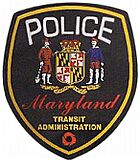 |
|
| Abbreviation | MTAP |
| Agency overview | |
| Formed | 1971 |
| Employees | 230 |
| Jurisdictional structure | |
| Operations jurisdiction | Maryland, USA |
| General nature | |
| Operational structure | |
| Headquarters | Baltimore, Maryland |
| Officers | 187 approx. (as of 2017) |
| Civilians | 40 approx. (as of 2017) |
| Agency executive |
|
| Parent agency | Maryland Transit Administration |
The MTA has its own police force. About 150 police officers work to keep the transit system and its passengers safe. The department started on October 1, 1971. Its officers are fully trained and have full police powers. The MTA Police have won awards for safety.
See also
 In Spanish: Administración de Transporte de Maryland para niños
In Spanish: Administración de Transporte de Maryland para niños


